We May Be The Grand Canyon State, But The Rocky Mountains Are Important For Arizona
 10 May 2022
10 May 2022 
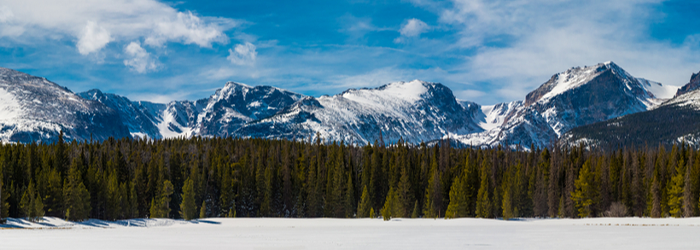
We May Be The Grand Canyon State, But The Rocky Mountains Are Important For Arizona
No doubt you have seen the stories on the news about the water shortages in the Southwest. We even made national news!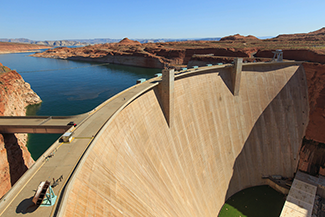
KTAR reported on May 4, 2022, that the U.S. Bureau of Reclamation announced plans to hold back approximately 480,000 acre-feet of water in Lake Powell to maintain Glen Canyon Dam's ability to produce hydropower for millions of homes and businesses in the region. This decision was made, in part, to preserve the ability to deliver the contractual volumes of water to Lake Mead, which serves the Lower Colorado River Basin, including Arizona.
The action will not have any immediate impact on the amount of water allocated for the region's cities. And it won't further affect farms that rely on the Colorado River, which are already dealing with mandatory cuts to the Central Arizona Project Supply.
How Arizona Gets Its Water
Although they are in Colorado, The Rocky Mountains are very important for Arizona and its inhabitants. When it melts, their snow becomes the same water we need for farming, drinking and recreation. When the Rockies and other mountains regions of the southwest see less than normal snowfall, it impacts millions of people.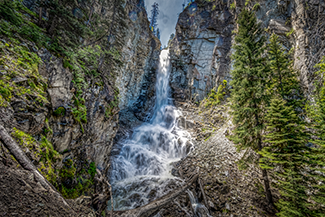
There is a lot of information floating around about the drought – what is causing it and how can we be assured that Arizonans will have enough water.
Vineetha Kartha, Colorado River Programs Manager, Central Arizona Project (CAP) explains where we get our water.
Arizona gets more than 30% of its water from the Colorado River Basin . The Basin is divided into an Upper Basin – Colorado, New Mexico, Utah, and Wyoming; and a Lower Basin – Arizona, California, Nevada, and by treaty, parts of northern Mexico.
Each Basin has a major reservoir. The Upper Basin reservoir is Lake Powell, on the Arizona/Utah border and the Lower Basin reservoir is Lake Mead, on the Arizona/Nevada border.
Lake Powell and Lake Mead operate “conjunctively.” That means that the operations of one affect the other. The system is designed to work so that runoff originating in the Upper Basin fills Lake Powell, and Lake Mead is filled by releases from Lake Powell and intervening flows below Glen Canyon Dam.
Water deliveries are not always direct. CAP works together with many local water districts to deliver water many miles away from the CAP canal itself. For example, each year the City of Buckeye buys water from CAP. That water is delivered via the Salt River Project’s (SRP) Buckeye Canal with the water they manage from the Salt and Verde Rivers. CAP then resupplies SRP with an equal amount of water at the CAP Salt Gila Pumping Plant just west of the Salt and Verde River confluence near the Maricopa/Pinal County border some 60 miles east of Buckeye. Integrations and partnerships in water deliveries like this are key elements in consistent and reliable water deliveries across Arizona.
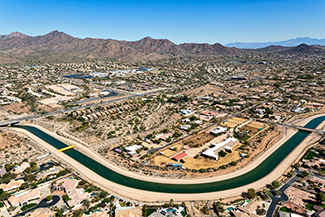
The Water Shortage
Person notes that as of January 1, 2022, Lake Mead has been operating under a Tier 1 shortage declaration, which was declared by the U.S. Secretary of the Interior. This has resulted in a substantial cut to Arizona’s share of the Colorado River – about 30% of CAP’s normal supply; about 18% of Arizona’s Colorado River supply; and just under 8% of Arizona’s total water use. These mandatory Arizona reductions are borne by our CAP water users. The result has been reduced availability of Colorado River water for central Arizona agricultural users.
The Colorado River Basin has been in a prolonged drought. We are experiencing the driest conditions in the Colorado River Basin in more than 1,200 years – and these conditions are expected to continue well into the future.
Both Lake Powell and Lake Mead are approaching critical elevations and will require unprecedented management actions to protect infrastructure in both the Upper Lower Colorado River Basins. Protecting infrastructure protects water supplies.
Tree ring research indicates the drought of 800 A.D. lasted over 80 years, if history is currently repeating itself, we are only a quarter way through the current drought. However, we have a lot of things our Native ancestors didn't have, and new developing water technologies are hitting the market at what feels like daily. Currently, Glanaris, a mom-and-pop shop in Alabama is turning rice hulls, the world's largest agriculture waste product that is normally burned, into the cheapest and most effective water filters on the market. This saves significant energy consumption on the mining and manufacturing of synthetic filters that cost more, and energy savings is water savings.
Some freshwater crops near oceans are being replaced with similar varieties of crops that are saltwater-tolerant, thus eliminating the need for direct fresh water to those fields where an endless supply of saltwater can be pumped nearby.
And by far the most significant under-utilized resource is the age-old practice of drilling primary water wells. This is not your typical groundwater well, primary water wells are sourced from deep beneath the Earth's crust where magma heat creates water in vapor form. As it reaches the Earth’s surface through cracks in the crust, the vapor cools and forms into liquid. If you have ever been to a natural spring, you have experienced the freshness of primary water. The warmer the spring is, the closer the magma vine is to the surface of the crust. Its estimated there is a two to three times larger volume of primary water beneath the curst than there is water on top of the Earth’s crust. This includes all the water in the oceans, lakes, rivers and atmospheric vapor. If that is true, think about this: only 1% of the Earth’s water is potable. This means we would only need to access .05 - .07% of primary water to double the amount of available fresh water on the Earth’s surface.
What Does The Drought Mean For Homeowners?
It is likely that Arizona will be in a Tier 2 shortage next year.
AZ Central reported on May 4, 2022, that Scottsdale and Tucson have declared themselves to be in the first stage of their respective drought plans and are reducing government water uses. Phoenix plans to take payments from the state in lieu of some of its Colorado River deliveries next year, part of the state’s latest drought mitigation effort.
While this situation is serious – it's important to note that supplies to homes and businesses do not face a threat in 2023. But the outlook for Arizona's Colorado River supply certainly warrants additional actions.
Everyone should commit to conserving water as the precious resource that it is. Conserving can delay or reduce further mandatory reductions to our supply.
The Central Arizona Groundwater Replenishment District
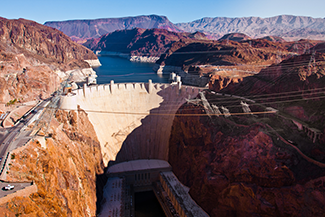 The Central Arizona Groundwater Replenishment District, known as CAGRD, was created in the mid-1990s to help water providers and landowners comply with Arizona’s groundwater laws. It is comprised of cities, towns, and private water companies, called Member Service Areas and Subdivisions, known as Member Lands. It is a special function of the Central Arizona Project, serving the same three-county service area – Maricopa, Pima, and Pinal Counties.
The Central Arizona Groundwater Replenishment District, known as CAGRD, was created in the mid-1990s to help water providers and landowners comply with Arizona’s groundwater laws. It is comprised of cities, towns, and private water companies, called Member Service Areas and Subdivisions, known as Member Lands. It is a special function of the Central Arizona Project, serving the same three-county service area – Maricopa, Pima, and Pinal Counties.
CAGRD plays an important role in Arizona’s groundwater management by replenishing groundwater pumped by our members.
In 1980, Arizona passed the Groundwater Management Act, one of the toughest groundwater laws in the country. This law regulated groundwater pumping in Arizona’s most populated areas. It also created the Assured Water Supply Program, which stated that new development could rely on groundwater but must assure a 100-year supply of groundwater, which must also be replenished.
The Arizona legislature created CAGRD to give water providers and landowners that rely on groundwater with a mechanism to replenish their groundwater pumping. CAGRD replenishes water into our aquifers – layers of sand and gravel beneath the ground. They send water to recharge basins where the water percolates through to the aquifer.
Click here to find out if you are in a CARGD Member Area.
What Can You Do?
Person encourages each of us to commit to at least one thing to conserve water. It is important to educate ourselves about our water provider’s drought plans and seek information about their water conservation programs.
CAGRD recently launched a conservation campaign. By its nature, CAGRD is aimed at protecting our precious water resources – replenishing the water our members pump and recharging our aquifers.
While not a water provider, CAGRD also supports and encourages conservation – because less groundwater use means less water that needs to be replenished.
In addition, CARGD recently launched a digital conservation campaign that you may be seeing in your social media feeds. Links to a special page will feature Water Use It Wisely, the Arizona Municipal Water Users Association , and Arizona Water Facts.
Yes, we are in a drought. No doubt about that. We all need to do our part, but panic and misinformation are not the answer. Stay tuned to Rosie on the House, as we will continue to closely monitor this issue.
There is a bounty of ideas and technology that can help solve tomorrow's problem, but it is individual water conservation that can solve today's problem!
Think twice about the water you’re using in your day-to-day life. Remember, energy saving equals water savings!
###
Podcast
Laura Grignano, Manager of Central Arizona Groundwater Replenishment District and Vineetha Kartha, Manager Colorado River Programs discuss how Arizona has been able to manage, conserve and store water with the Tier 1 Shortage in Lake Mead. With decades of water management, they explain in detail what will keep the water flowing to homes and agriculture. Plus what Tier 2 and Tier 3 shortage could mean for Arizona.
Photo Credits:
- Environmental Protection Agency
- Shutterstock
Related Content
- Blog: Security of the Electric Grid System in Arizona
- Blog: Central Arizona Project Canal | Arizona's Source for 35 of Its Water Resources
- Blog: Water Usage & Conservation
- CAP: Know Your Water News
Print this page
recent post
- Duck, Duck, Duct! How Often Should Ductwork Be Cleaned?
- Vinyl vs. Fiberglass Windows: Which Is The Better Choice Of Replacement Window?
- We May Be The Grand Canyon State, But The Rocky Mountains Are Important For Arizona
- Welcome to Arizona! Things A Newbie to Arizona Should Know
- The Pros & Cons of Buying A Flipped House
- Getting In On The Ground Floor
- Why It’s More Critical Than Ever To Get Your AC Serviced Before Summer
- The Reality of Remodeling
- What To Look For When Comparing Your Roofing Quotes
- What To Expect When Buying New Windows & Doors
